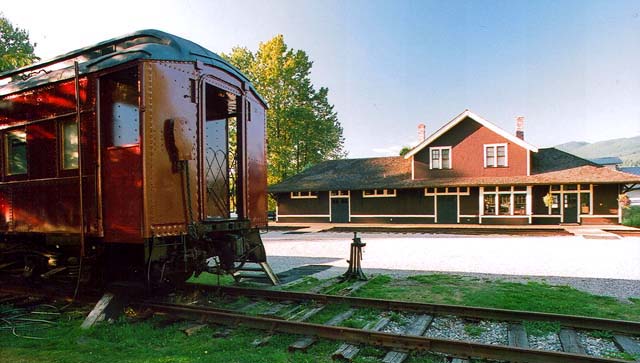
2012
|


Ex-Canadian Pacific Railway car Venosta and the Port Moody Museum - Date/Photographer unknown.
9 June 2012
Port Moody Museum Documents History
Port Moody British Columbia - Port Moody was the original Asia gateway for migrant laborers and now a new museum exhibit will tell
their story.
The Port Moody Station Museum is hosting the exhibit "Chinese Legacies: Building the Canadian Pacific Railway in B.C." so people understand the
contributions of Chinese workers to Canadian history.
Most people associate Chinese labourers with bigger cities, such as Vancouver, Victoria, and even New Westminster, where large ghettos of mostly male migrant
workers lived. But, according to museum manager Jim Millar. Port Moody has a deep historical connection to the Chinese railway workers because it was the
original terminus for the CPR.
Thousands of workers came from China by ship into the region before traveling on to the construction sites to Kamloops Lake, and Craigellachie where the last
spike was pounded in 1885. The workers were recruited by Andrew Onderdonk, the main construction contractor for the CPR, but many fell ill with Beri Beri
disease upon their arrival and were buried on the hillside in Port Moody.
Later, though, their bodies were exhumed and returned to China for final burial.
This unknown bit of history will be revealed to visitors who will learn how these Chinese workers lived, worked, and socialized. There's even a diorama
depicting a typical camp and artifacts such as clothing and games, with some of the pieces coming from the Port Moody museum's own archives.
"Many people don't know about this part of Port Moody's history," said Millar of the exhibit which was created by the Revelstoke Museum &
Archives in partnership with the Revelstoke Railway Museum.
The exhibit recounts the difficulties that faced some 15,000 Chinese workers between 1880 and 1885. It is estimated that between 600 and 2,200 workers lost
their lives due to malnutrition, dangerous working conditions, and diseases during this time.
The workers were also discriminated against and were paid half the salary of white workers and were forced to do the most dangerous work in the camps.
"The exhibit speaks to our national story and recognizes the countless contributions and sacrifices the Chinese workers made for Canadian nation
building," Millar said.
To celebrate the arrival of this exhibit, the museum will be hosting weekly family days every Sunday in July and August, starting Canada Day weekend.
The museum is located at 2734 Murray Street, Port Moody B.C. For more information, visit portMoodyMuseum.org.
Diane Strandberg.

|
